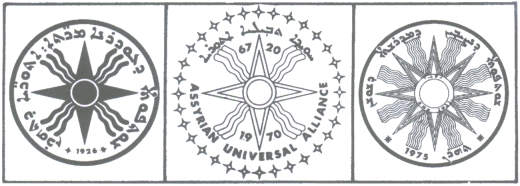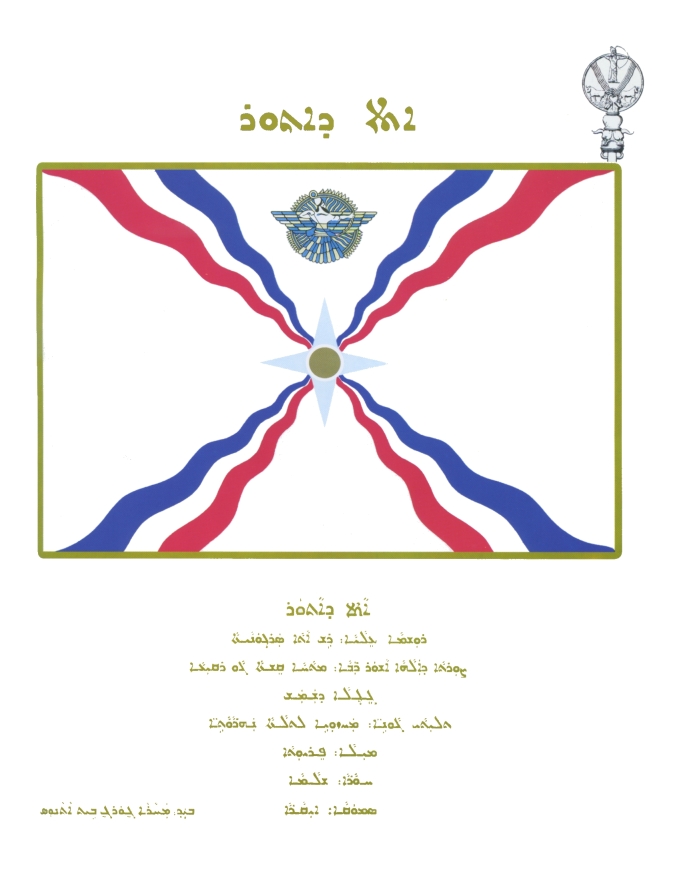

 This article is an excerpt from a book titled The Assyrian Flag. It is in the form of an extensive interview that Mr. Homer Abramian, the chief editor of Kirkha (an Assyrian periodical published in Iran), had with the designer of the Assyrian flag, Mr. George Bet Atanous (1919-2000).
This article is an excerpt from a book titled The Assyrian Flag. It is in the form of an extensive interview that Mr. Homer Abramian, the chief editor of Kirkha (an Assyrian periodical published in Iran), had with the designer of the Assyrian flag, Mr. George Bet Atanous (1919-2000).
The interview touches on many different topics including the history, mythology, and the art of ancient Assyrians as well as contemporary issues regarding the legal status of the Assyrian minority in the constitution of Iran in the post Islamic revolution era.
George Bet Atanous published this interview in the form of a book to be distributed freely to friends and fellow Assyrians. It should be noted that almost every page is adorned with ancient Assyrian art motifs and designs, some of which he analyzes as to their symbolic significance in response to the questions from the interviewer. In that context, he also tells the reason why he was prompted to design the present Assyrian national emblem, the flag, and how he chose the representational symbols for it.The book is in Farsi, dedicated to the memory of his mother. Reliable research indicates that the interview was conducted in the autumn of 1980. Since many are not aware of the meaning behind the different symbols and colors in it, upon request I have translated an excerpt from the book to familiarize the Assyrian readers with their flag and its designer.
George Bet Atanous is known as a self-taught Assyriologist and a seismic engineer by profession. His prime interest was to learn about the ancient Assyrian history, mythology, literature and art.

He was elected as the Assyrian Man of the Year during the Assyrian Universal Alliance (AUA) congress in San Francisco, USA in 1979. On that occasion he was also granted an honorary doctorate for his invaluable contributions in promoting appreciation for the historical, literary, and artistic legacy of ancient Assyrians, as well as for reviving and preserving the ancient lore and icons.
George Bet Atanous was born in Russia in 1919. His parents were originally from the town of Urmia. They had immigrated to Russia before WWI; but returned to Iran after the political upheavals in Russia in 1927.
His elementary education took place in a Russian school in Anzali Port (Gazian). He continued his high school education in Teheran, and after completing his military service; he enrolled in the University of Calcutta where he obtained his bachelor degree in Topography in 1951. Meanwhile in addition to his work as a topographer, he began to take advanced courses in design and syncopation of seismographic equipment. He received a Master's degree in Seismology in 1968 from the Department of Education in Hungary.
George Bet Atanous passed away on October 10, 2000.
He was an active member of several Assyrian educational organizations. He had an in- depth knowledge of Assyrian epics and mythological figures, and believed that there was considerable resemblance between Assyrian cosmology and mythology and that of the Greeks and Romans. He collected ancient Assyrian art designs and studied their symbolic significance. Using motifs from engravings such as the Assyrian Star or the human-headed winged bull or guardian spirits, he designed medals, coins, plaques, or jewelry in the form of cufflinks or tie pins in order to revive and preserve the ancient Assyrian motifs. His two favorite art objects were the human-headed winged bull and the Shamash Disc (known as the Assyrian Star).
According to him the winged bull is the symbol of greatness, strength and stamina. Despite its colossal size, it is the finest example of artistic mastery in grace and refinement of lines. The human-headed winged bulls or winged lions (Lamassu) are known as "Gateway figures" because they were placed at the entrance of palaces as guardian spirits on either side of the entrance, sometimes face-to-face, sometimes side by side. The human-headed winged bull symbolizes several virtues:
1 - The body represents the strength and stamina of a bull.Any person or nation with these three attributes: strength, wisdom, and speed is capable of maintaining its independence.
2 - The human head is the symbol of higher intellect and wisdom.
3 - The wings represent speed
As to the symbol of the Assyrian Star, he believed that the symbol does not represent a star, but the god Shamash, the sun disc. The sun disc comes in two forms in the ancient Assyrian designs. The first has four points or horns surrounded by four sets of rays. Each set might be composed of one, two or three rays. The other type has eight horns or points with seven or eleven sets of rays.

There is one unique version dating back to third millennium B.C. It is made of ceramic and glass and was used as a necklace.
The design is in high relief. It has a single wide ray that starts at the center and radiates out to the four corners of the object. In between the rays there are eight spheres that may represent planets in the sky. Seen represents the moon and is the god of irrigation, and agriculture. Seen is also known as the night sun. At the same time Ishtar is also referred to as the Sun god in the Assyrian tablets. The next sphere represents Meeroodakh, or Mars. Due to its red color, this planet was well known.
The third is Bel or Saturn. The fourth is Nebu, or Mercury. The fifth is Yav or Jupiter. The sixth is Shamash or Sun and the two others are probably representations of Venus, which appears twice every twenty-four hours; once in the morning, and once in the evening.
With respect to colors, a careful examination indicates that stone engravings representing the Sun god are left natural; but those made out of ceramic contain gold pigments to represent a fiery sun that endows the earth with life.
George Bet Atanous was an athlete himself. It was with envy that he observed, at the Olympic Games held in Berlin, Germany, that the different teams each was carrying its own national flag with pride. To quote his own words: "I was an athlete in my spare time. I envied the participating countries carrying their flags. I thought to myself: Why is it that we have not attained the success to take part in such games while carrying our own flag?" The establishment of AUA in 1968, created an opportunity for him to participate in the bid to design a flag for the Assyrians of today. He presented his design to the Executive Board of AUA during its 3rd Annual Convention. His design was unanimously accepted. The reason for the enthusiastic approval of his design was that George Bet Atanous had not created a new design, but had chosen the existing motifs and icons found in the ancient Assyrian symbols. He had extracted and reassembled those motifs in such a way that the design would be pleasing to the eye, and at the same time establish the Assyrian national continuity and reawaken a sense of pride in being an Assyrian.
The choice of the colors for the flag was also based on ancient Assyrian artistic tradition:
1 - The center image which is the Shamash Disc (sun) is golden to represent fire as the source of life.The Akkadian name of Tigris is Diglat or Tigla meaning date palm. Palm trees grew along the banks of this river in thick rows, which probably inspired the name of the river.
2 - Among the four wings, the middle or principal one is sky blue; symbol of happiness.
3 - The three points that are in between the wings and branch out to four directions represent either rays of light or rivers. The artist's choice went for the rivers, which he extends to four directions. The imagery mirrors the condition of the Assyrians of today-- i.e. scattered in the four corners of the world -- and the hope of finding their way back by the same route.
4 - The three rivers are Tigris, Euphrates, and Zab. Euphrates is colored blue to symbolize plentitude. Zab is colored white to represent peace; Tigris is colored red to symbolize pride. Above the Shamash disc is the god Ashur in war gear with original colors in engravings found in the British Museum.
5 - At the head of the flagpole is the Standard of Sargon II, which was originally in gold and was always held above the king's head so that the generals could immediately locate the king in the battlefield.
Euphrates in Akkadian is Prat, which means plentitude. This river was surrounded by agricultural fields that it irrigated and sustained the people.
George Bet Atanous also designed various coins, plaques and medals for AUA and other Assyrian organizations to be used as trophies or awards of appreciation for worthy Assyrians who have served their nation well.

Original Assyrian flag design.

or register to post a comment.